New Approaches to Closing the Fiscal Gap

Download↓
In most countries, gross domestic product (GDP) and employment have fully recovered their 2019 levels, although forecasted growth rates might be said to be “resiliently mediocre”: banking systems appear sound, and rising debt burdens are manageable so far, but growth is not expected to exceed the low levels of the 2010 decade. Poverty in terms of income (monetary poverty) has largely receded with the economic recovery, but the longer‐term scars of the pandemic in terms of education and health have planted deep seeds of future inequality. Redressing these problems and undertaking the structural reforms needed to reach higher levels of growth and reduce poverty remain central on the policy agenda.
The new and unwelcome entrant in the policy space is inflation. While comparable to advanced country levels and well managed by regional monetary authorities, inflation nonetheless is being propelled by forces that may give it more staying power than originally hoped. Finally, public deficits induced by the pandemic and the need to finance critical government programs and directions have opened a fiscal gap and led to constrained fiscal space. The need to close the fiscal gap, put debt on a sustainable footing, and generate fiscal space to finance necessary physical and social investments has led to a search for new revenues and in particular to pressure to increase income taxes. In looking at any tax hike, concerns center on the possible depressive effects on growth, overall progressivity, and possible incentives for informality. This report presents new evidence on these effects for value added taxes (VAT) and income taxes. It also advocates for steps to cut wasteful government spending and increase government efficiency - both to generate substantial resources and as an entry point to a broader agenda of state modernization and generating public trust.




















































First, please LoginComment After ~